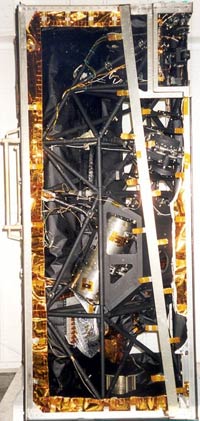Hubble's Instruments: FOS - Faint Object Spectrograph
The Faint Object Spectrograph (FOS) was replaced by STIS during the Second Servicing Mission and brought back to Earth.
A spectrograph spreads out the light gathered by a telescope so that it can be analysed to determine such properties of celestial objects as chemical composition and abundances, temperature, radial velocity, rotational velocity, and magnetic fields.
The Faint Object Spectrograph (FOS) examined fainter objects than the GHRS, and could study these objects across a much wider spectral range.
The FOS had two modes of operation - low resolution and high resolution. In low resolution mode it reached 26th magnitude in one hour with a resolving power of 250. At high resolution, the FOS reached only 22nd magnitude in an hour, but the resolving power was increased to 0.9 Angstroms at 120 nanometres.
FOS Facts |
|
| Instrument type | Spectrograph |
| Resolution | Low resolution - 5 Angstroms at 120 nanometres High resolution - 0.9 Angstroms at 120 nanometres |
| Wavelength range | 115 to 850 nm |
 The Faint Object Spectrograph (FOS). This picture was taken after FOS was brought back to the Earth again.
The Faint Object Spectrograph (FOS). This picture was taken after FOS was brought back to the Earth again.
|